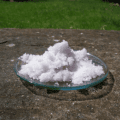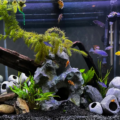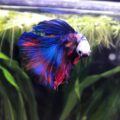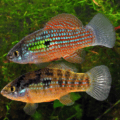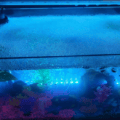We as hobbyists have a wide range of options when it comes to creating a unique-looking tank. One of the options at our disposal is to diversify our setup with a transparent aquarium fish species. Although these see-through fish aren’t the most popular, as you’ll find out for yourself, they can be quite interesting and are relatively undemanding when it comes to care.

Transparent fish usually have a body that allows light to pass straight through.
However, during my research, I’ve found that in some cases these fish might be classified as such even if their body is translucent.
Without getting any further, let’s look at what makes these clear fish special and why you should include them in your tank.
Top 14 Transparent aquarium fish species
Despite some common misconceptions, see-through fish don’t belong to a single genus, but to several different ones.
For the purpose of this list, I’ve tried to pick the most interesting specimens in terms of their looks and behavior.
Here are the top 14 transparent aquarium fish species:
1. Glass Catfish – Kryptopterus vitreolus

| Minimum Tank Size: | 30 gallons |
| Maximum Body Size: | 3.1 inches (7.8 cm) |
| Water Temperature: | 74 – 79 °F (23.3 – 26.1 °C) |
| Care Level: | Intermediate |
The Glass Catfish is known by many different names, such as ghost catfish or phantom catfish, but each of them is used to denote different species of skeleton catfish from the Kryptopterus genus.
These fish originate from South Asia where they inhabit slow-moving streams and rivers with lush vegetation.
This is why they prefer planted tanks that reflect their natural habitat and have plenty of hiding spots.
Despite their intimidating appearance, Glass Catfish are actually quite timid in nature and take time to adapt to their new surroundings. However, when they finally do, they start exploring the entire tank, unlike other catfish which typically stay at the bottom.
The peaceful demeanor of Glass Catfish makes them an ideal community tank member, as long as they are kept with other fish of similar disposition. As such, Mollies and Celestial Pearl Danios would be great tank mates.
You should also keep in mind, Glass Catfish are a schooling species and need to be kept in groups of at least 6. Due to their sensitivity to changes in water parameters, these transparent fish are not a suitable choice for beginners.
2. Indian Glassy Fish – Parambassis ranga
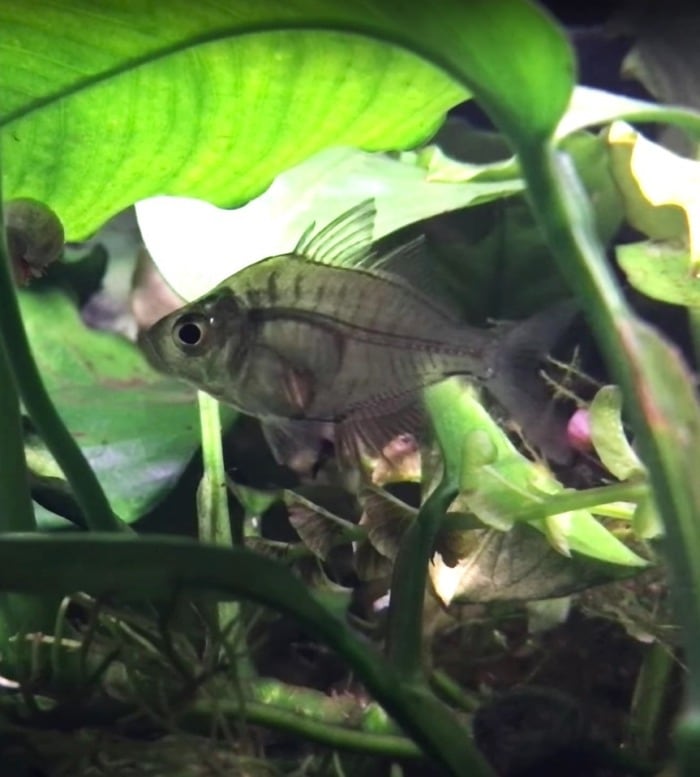
| Minimum Tank Size: | 30 gallons |
| Maximum Body Size: | 3.2 inches (8.1 cm) |
| Water Temperature: | 68 – 86 °F (20 – 30 °C) |
| Care Level: | Moderate |
You may encounter the Indian Glassy Fish sold as a “Disco Fish” or “Painted Glass Fish”.
Unfortunately, these are nothing more than artificially colored variants and I wouldn’t advise getting any of them.
Author’s note: The artificial dying of fish is an especially cruel process. In some cases, it involves temporarily removing the protective slime layer of the fish. Most fish don’t survive the tremendous amounts of stress they’re put under, and the ones that do have a severely shortened lifespan.
Anyway, the Indian Glass Fish is a transparent freshwater species that typically inhabits areas of slow-moving or still water, including river deltas. Due to this, it can adapt to a wide range of water conditions and also be kept in brackish aquariums.
The Glassy fish has a calm nature and shouldn’t be housed with any violent fish.
In freshwater aquariums, this fish could be kept with loaches, barbs, and rainbowfish, while mollies and sifter gobies are suitable options for brackish setups. Being a shoaling species, the Parambassis ranga needs to be kept in groups of at least 6 fish for optimal health.
3. X-Ray Pristella – Pristella maxillaris
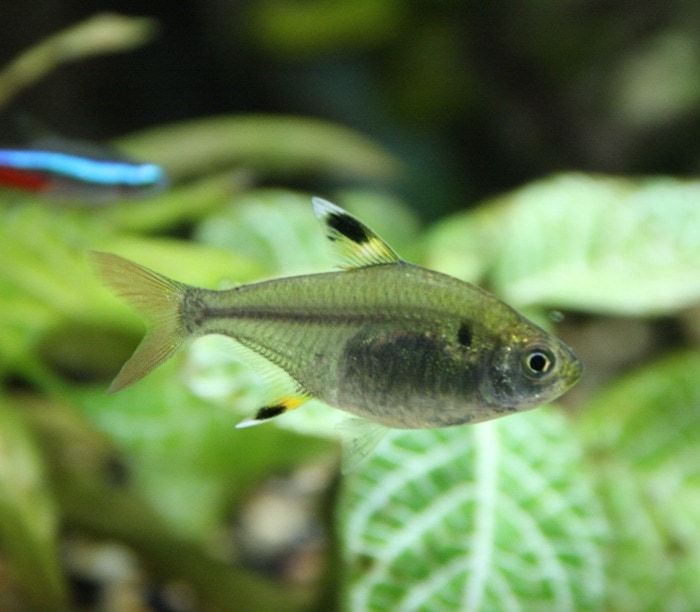
| Minimum Tank Size: | 15 gallons |
| Maximum Body Size: | 1.9 inches (4.8 cm) |
| Water Temperature: | 74 to 82 °F (23.3 – 27.7 °C) |
| Care Level: | Beginner |
The X-Ray Pristella is a see-through fish that’s native to Venezuela and Northern Brazil.
It inhabits freshwater streams and tributaries during the dry season and moves to flooded areas of the savannah when the wet season begins.
In some cases, it can also be found in brackish waters near the coast of Venezuela.
In terms of temperament, the Pristella maxillaris is known for its easy-going nature and should be kept with other small South American species like dwarf cichlids, tetras, and corydoras.
The X-Ray Pristella is easy to take care of and has a peaceful nature. It can usually be purchased from most live fish stores at a reasonable price.
These qualities make it a great choice for complete beginner aquarists.
Just like the Indian Glassy Fish, the X-Ray Pristella is also a shoaling fish and should be kept in groups of at least six.
4. Glass Bloodfin Tetra – Prionobrama filigera
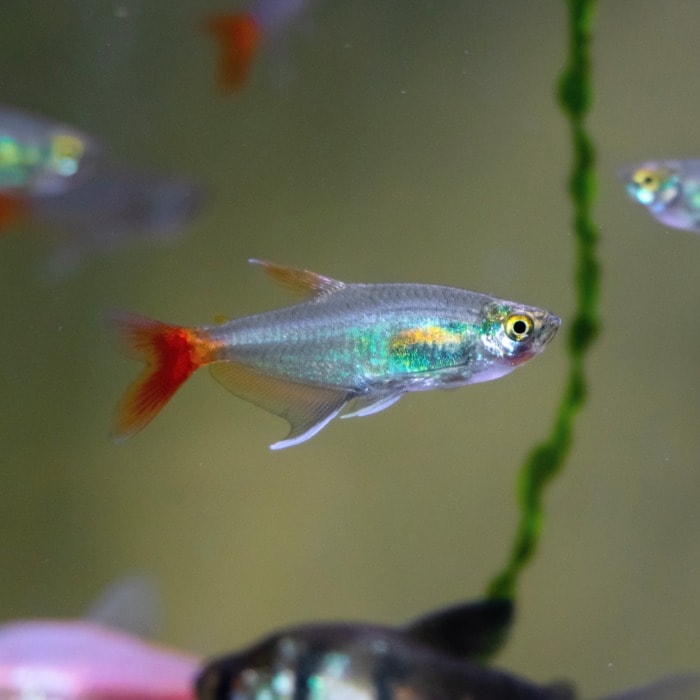
| Minimum Tank Size: | 30 gallons |
| Maximum Body Size: | 2.36 inches (6 cm) |
| Water Temperature: | 73 – 81 °F (23 – 27 °C) |
| Care Level: | Beginner |
Unlike the plain appearance of the other entries so far, the clear body of the Glass Bloodfin Tetra is neatly adorned with crimson fins.
This creates an appealing contrast which is even more striking when Bloodfin Tetras are coupled in groups.
These see-through tetras are native to the Amazon River, but also inhabit smaller streams, tributaries, and creeks.
They’re usually found in the upper layers of the water and because of this, they require a sufficient amount of space for swimming when they’re housed in an aquarium.
Bloodfin Tetras can be a bit shy when they first get introduced in an aquarium, especially if they’re alone or kept in small groups. Using surface-water plants and making sure to keep these fish in groups of at least 6 will ease the adaptation to their new surroundings.
If you want to make your Bloodfins feel at home, you can use some wild-found driftwood and cover the substrate with some plant litter. These fish get along with most South American species, but you should avoid keeping them with bigger and fast-swimming fish.
5. Glass Knifefish – Eigenmannia lineata
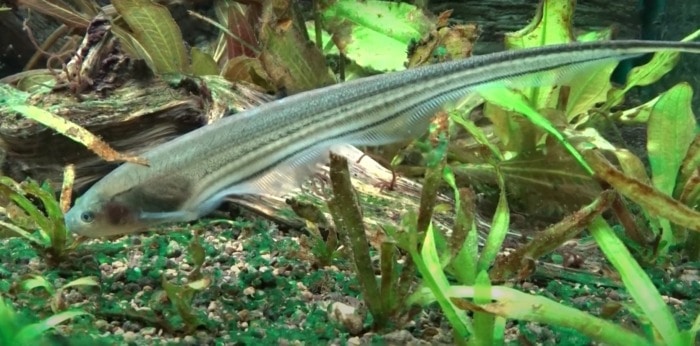
| Minimum Tank Size: | 125 gallons (should be long) |
| Maximum Body Size: | 17.7 inches (45 cm) |
| Water Temperature: | 73 – 82 °F (23 – 28 °C) |
| Care Level: | Beginner |
Glass Knifefish can be found in a variety of environments all over South America, typically ones deep underwater with lots of plant debris.
Due to this, they have flat bodies that help them move swiftly in the deep.
What’s more interesting about these transparent fish, however, is their ability to receive and send electric signals. They achieve this through a specialized area in their brain that sends electric impulses to their tail where they subsequently get discharged.
These impulses are weak and are primarily used for navigation and communication.
If you intend on keeping a Knifefish, you should provide its fish tank with enough hiding spots in the form of caves, driftwood, or plants.
Although they’re considered a peaceful species, the Knifefish are still predators and should be kept with fish of their size or bigger.
6. Glowlight tetra – Hemigrammus erythrozonus
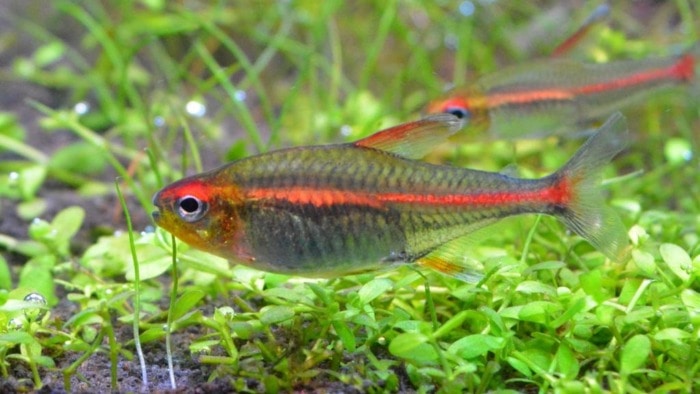
| Minimum Tank Size: | 10 gallons |
| Maximum Body Size: | 1.5 inches (4 cm) |
| Water Temperature: | 74 to 82 °F (24 to 28 °C) |
| Care Level: | Beginner |
Glowlight tetras are one of the go-to choices for most community setups due to their relative hardiness and visual appeal. They’re also quite cheap, which along with their hardiness makes them perfect for inexperienced fishkeepers.
In the wild, these clear fish live in forested areas with murky and highly acidic waters.
You can match these conditions by using a few driftwood branches, some twisted roots, and floating plants.
These will reduce the pH of your water and make your Glowlight tetra feel right at home.
Glowlight tetras usually get along with peaceful bottom-dwelling plecos, rasboras, other tetras as well as most livebearers. This, however, doesn’t apply to larger predatory species of fish such as angel fish.
Author’s note: One of my favorite combos for fish in a planted tank is Chili Rasboras and Glowlight tetras. Both species remain small and thrive in acidic water while adding some personality to the tank.
7. Micro rasbora – Microrasbora rubescens
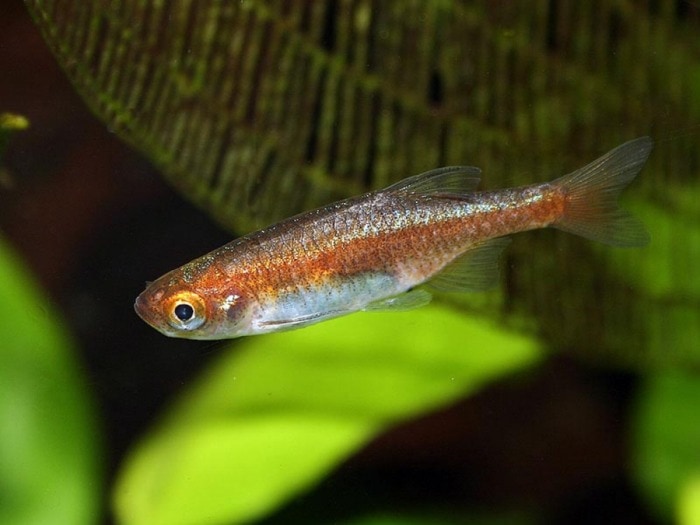
| Minimum Tank Size: | 5 gallons |
| Maximum Body Size: | 0.8-1 inches (2-2.5 cm) |
| Water Temperature: | 68 – 82.4 ° F (20 – 28 °C) |
| Care Level: | Moderate (requires very clean water to thrive) |
These cute microfish are known under many aliases with ‘red-line dwarf rasbora’, ‘red dwarf rasbora’, and ’emerald dwarf rasbora’ being just some of them.
In the wild, micro rasboras are only found in a single mountain lake in Myanmar.
Because of this, they have very specific water requirements that need to be met.
Their water needs to be very clean and slightly acidic, with a pH of about 6.0.
You can increase the acidity of your water by adding some leaf litter and driftwood.
Author’s note: The unsustainable agricultural practices around lake Inle along with the introduction of non-native species of fish, have led to a substantial decline in the population of Microrasbora rubescens. As a result, the Microrasbora rubescens has been classified as an endangered species.
Anyhow, when it comes to tank mates, the micro rasbora should not be housed with larger species because they may intimidate it and outcompete it for food.
These clear fish seem to do well with other surface-dwelling species of a similar size.
The micro rasbora is a shoaling species and should be kept in groups of at least 8 specimens.
This will help it feel calmer and reduce its skittish behavior.
8. Green Neon Rasbora – Microdevario kubotai

| Minimum Tank Size: | 15 gallons |
| Maximum Body Size: | 0.8 inches (2 cm) |
| Water Temperature: | 68 – 80.6 °F (20 – 27 °C) |
| Care Level: | Intermediate |
Interestingly enough, most of the Green Neon Rasboras sold on the market are wild-caught rather than cultivated.
Because of this, their water conditions should closely match those of their natural habitat.
This means supplying them with water that’s rich in oxygen and slightly acidic at the same time.
This can be done by providing a moderate water current that doesn’t overwhelm the Green Neon Rasbora.
These fish are schooling species that form groups of between 20 and 50 specimens in the wild.
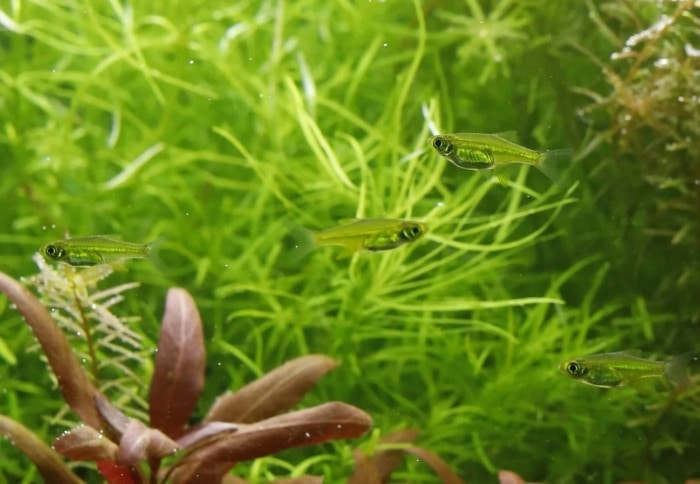
This, of course, doesn’t mean you should rush to your local fish store and buy all of their stock. Eight rasboras should be more than enough for your purposes and a small tank.
These cuties are rather peaceful and should be kept with other fish of a similar disposition such as Harlequin rasboras and small tetras.
9. Hummingbird tetra – Trochilocharax ornatus

| Minimum Tank Size: | 10 gallons |
| Maximum Body Size: | 0.75 inches (1.9 cm) |
| Water Temperature: | 68 – 82 °F (20 – 27.8 °C) |
| Care Level: | Moderate |
Hummingbird tetras have won the praise of many aquarists and enthusiasts with their visual appeal.
Their crystal-colored bowels give them an ethereal look that is yet to be matched by another species of freshwater fish.
Consequently, this has made them one of the most sought-after fish in the hobby.
The origins of these transparent fish are highly-debated, but it’s presumed they inhabit minor forest streams and tributaries.
Without any clear information I could go about, I had to do some tinkering to get the right conditions for their environment.
What I found out was that these fish prefer being kept in setups with low exposure to light and a lot of vegetation.
Although Hummingbird Tetras are calm in nature, they aren’t the best community fish due to their small size and specialized requirements.
They should either be kept alone or with smaller bottom-dwelling fish.
10. Dwarf Scissortail Rasbora – Rasbosoma spilocerca

| Minimum Tank Size: | 20 gallons |
| Maximum Body Size: | 1.2 inches (3 cm) |
| Water Temperature: | 73 – 79 °F (22 – 26 °C) |
| Care Level: | Intermediate |
It’s not often you can find a Dwarf Scissortail Rasbora in the hobby, and it’s not because they’re rare.
The plain and unassuming look of these fish just isn’t all that attractive to most hobbyists, which is a shame.
These clear fish can be fun and exhibit some interesting behaviors when they are kept in groups.
Dwarf Scissortails are found in still bodies of water like swamps, marshes, and floodplains with dense vegetation.
As a result, they will appreciate a heavily-planted aquarium with a dark substrate. In my experience, floating plants like the dwarf water lettuce along with some driftwood roots and fish tank soil seem to work great.
I wouldn’t recommend Dwarf Scissortails to beginners, because they can be really sensitive to changes in the water chemistry.
11. Dracula Fish – Danionella dracula
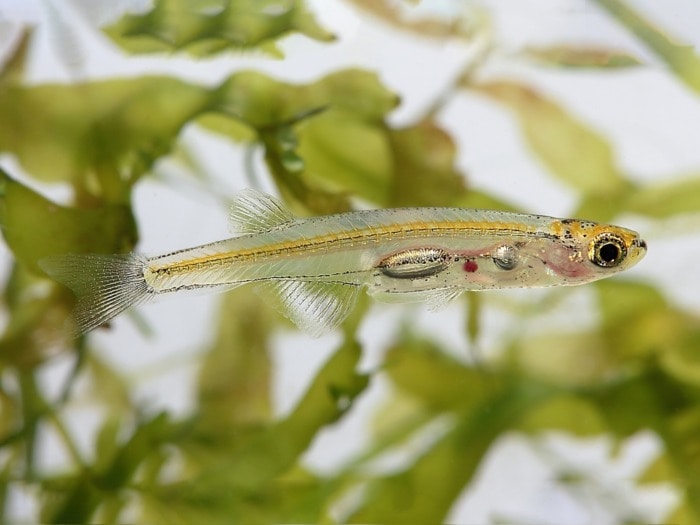
| Minimum Tank Size: | 10 gallons |
| Maximum Body Size: | 0.65 inches (1.67 cm) |
| Water Temperature: | 66 to 78.8 °F (19 – 26 °C) |
| Care Level: | Beginner |
The imposing name of these fish may lead you into believing they’re some bloodthirsty monsters lurking in the depths of the Amazon river.
That’s until you see one and start wondering who came up with its silly name:
Although Dracula fish don’t have actual teeth, they do possess two tiny teeth-like extensions protruding from their jaws.
These extensions reminded the scientists who identified it of the infamous count from Brahm Stoker’s novel, which consequently led to its name.
The Dracula fish was first identified in 2007 and is one of the final additions to the Danionella genus.
Due to their miniature size, these fish are best kept in species-specific tanks or with other small and peaceful fish such as the Green Neon Rasbora or the Hummingbird tetra.
12. Blushing Skirt Tetra – Gymnocorymbus ternetzi

| Minimum Tank Size: | 20 gallons |
| Maximum Body Size: | 2 inches (6 cm) |
| Water Temperature: | 75 °F – 80 °F (24 – 26 °C) |
| Care Level: | Beginner |
Many aquarists believe Blushing Skirt Tetras are a separate species, but they’re only a variation of Black Skirt Tetras. As such, they have the same water requirements as their tawny cousins and will thrive in a planted aquascape.
You may find these tetras sold under different trade names such as “Painted Glass Tetra” or “Strawberry Tetra”, but unfortunately these are nothing more than artificially dyed specimens.
Blushing Skirt Tetras are a fairly peaceful species of fish but may eat their own eggs, so they should be moved to a separate tank after they spawn.
When it comes to tank mates, they fare well with other species of a similar size such as Dwarf Gouramis, Zebra Danios, and Mollies.
13. Humphead Glassfish – Parambassis pulcinella
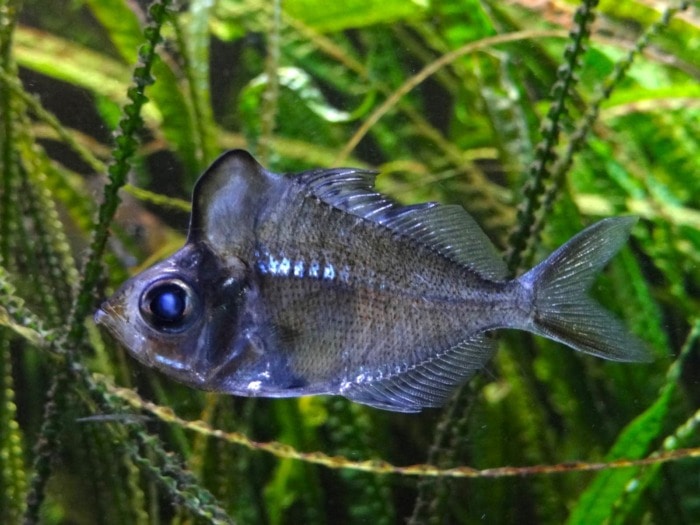
| Minimum Tank Size: | 20 gallons |
| Maximum Body Size: | 4 inches (10 cm) |
| Water Temperature: | 74 °F – 81 °F (23 – 27 °C) |
| Care Level: | Moderate |
These oddballs are a relatively new species of fish that was discovered in 2003.
In the wild, they are schooling fish that inhabit fast-flowing streams and rivers with clear, oxygen-rich waters.
Their social nature, however, doesn’t crossover well to life in the aquarium and they tend to be aggressive toward each other.
The presence of multiple males seems to increase the likelihood of violent outbursts.
To ensure they’re on their best behavior, they should be kept in a school of at least eight specimens with no more than two males.
Although Humphead Glassfish don’t exhibit aggression toward other species, they might intimidate smaller fish with their overactive behavior.
For this reason, it’s better to house them alone or with fish of their caliber.
In terms of their environment, Humphead Glassfish aren’t exactly picky but do require highly oxygenated water so you should provide them with a moderate water current.
14. Ghost Shrimp – Palaemonetes paludosus

| Minimum Tank Size: | 5-10 gallons |
| Maximum Body Size: | 1.5 inches (3.8 cm) |
| Water Temperature: | 65 – 82 °F (18 – 28 °C) |
| Care Level: | Beginner |
Despite their peculiar looks, Ghost Shrimp are great for beginners because they can regulate the levels of waste in an aquarium. They achieve this by eating decaying plant matter and even fish that have died in the tank and went unnoticed.
Getting a bunch of these see-through shrimp will sustain the levels of needless waste in a tank at a minimum. Apart from their usefulness, they’re also quite active and it’s fun watching them struggle against the water current.
Ghost shrimp typically have tiny clear bodies which are covered in gray spots.
Their exoskeleton is quite delicate, so it’s better to avoid using any sharp decorations. In terms of tank mates, they can be housed with Bettas and other shrimp species of relative size or small bottom-dwelling fish.
What is your favorite see-through fish?
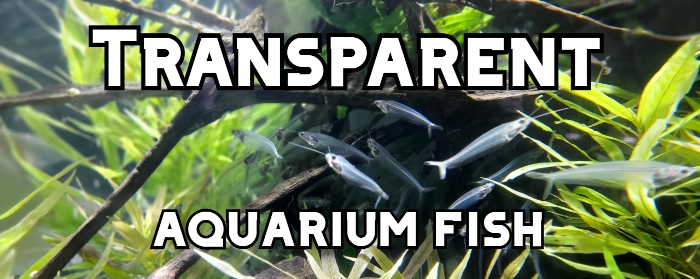
The notion of transparent fish sways many into thinking there’s nothing that sets these species apart.
I hope this list helped you realize that’s not the case and that you’re ready to give them a chance.
If you are not a newbie in keeping these beauties, I will be more than happy if you’d share with me your favorite species.
Do you prefer a mixture of clear fish or are you a single-species supporter?
Share your thoughts in the comments below!




